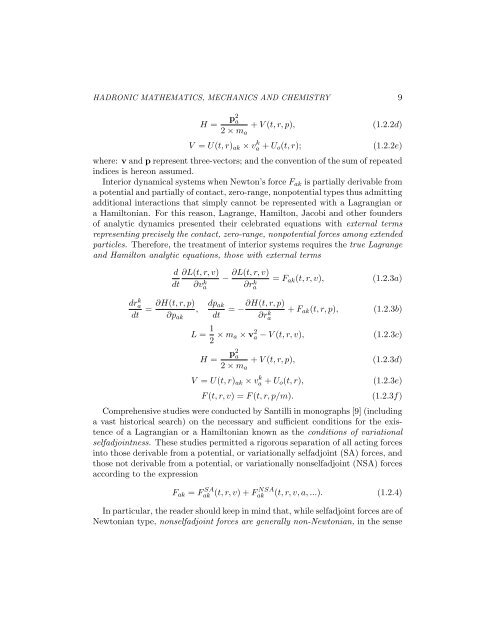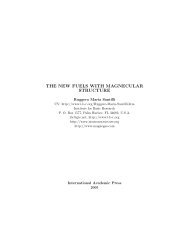hadronic mathematics, mechanics and chemistry - Institute for Basic ...
hadronic mathematics, mechanics and chemistry - Institute for Basic ...
hadronic mathematics, mechanics and chemistry - Institute for Basic ...
You also want an ePaper? Increase the reach of your titles
YUMPU automatically turns print PDFs into web optimized ePapers that Google loves.
HADRONIC MATHEMATICS, MECHANICS AND CHEMISTRY 9<br />
H =<br />
p2 a<br />
2 × m a<br />
+ V (t, r, p), (1.2.2d)<br />
V = U(t, r) ak × v k a + U o (t, r);<br />
(1.2.2e)<br />
where: v <strong>and</strong> p represent three-vectors; <strong>and</strong> the convention of the sum of repeated<br />
indices is hereon assumed.<br />
Interior dynamical systems when Newton’s <strong>for</strong>ce F ak is partially derivable from<br />
a potential <strong>and</strong> partially of contact, zero-range, nonpotential types thus admitting<br />
additional interactions that simply cannot be represented with a Lagrangian or<br />
a Hamiltonian. For this reason, Lagrange, Hamilton, Jacobi <strong>and</strong> other founders<br />
of analytic dynamics presented their celebrated equations with external terms<br />
representing precisely the contact, zero-range, nonpotential <strong>for</strong>ces among extended<br />
particles. There<strong>for</strong>e, the treatment of interior systems requires the true Lagrange<br />
<strong>and</strong> Hamilton analytic equations, those with external terms<br />
d ∂L(t, r, v) ∂L(t, r, v)<br />
dt ∂va<br />
k −<br />
∂ra<br />
k = F ak (t, r, v), (1.2.3a)<br />
dr k a<br />
dt<br />
=<br />
∂H(t, r, p)<br />
∂p ak<br />
,<br />
dp ak<br />
dt<br />
∂H(t, r, p)<br />
= −<br />
∂ra<br />
k + F ak (t, r, p), (1.2.3b)<br />
L = 1 2 × m a × v 2 a − V (t, r, v),<br />
(1.2.3c)<br />
H =<br />
p2 a<br />
2 × m a<br />
+ V (t, r, p), (1.2.3d)<br />
V = U(t, r) ak × v k a + U o (t, r),<br />
F (t, r, v) = F (t, r, p/m).<br />
(1.2.3e)<br />
(1.2.3f)<br />
Comprehensive studies were conducted by Santilli in monographs [9] (including<br />
a vast historical search) on the necessary <strong>and</strong> sufficient conditions <strong>for</strong> the existence<br />
of a Lagrangian or a Hamiltonian known as the conditions of variational<br />
selfadjointness. These studies permitted a rigorous separation of all acting <strong>for</strong>ces<br />
into those derivable from a potential, or variationally selfadjoint (SA) <strong>for</strong>ces, <strong>and</strong><br />
those not derivable from a potential, or variationally nonselfadjoint (NSA) <strong>for</strong>ces<br />
according to the expression<br />
F ak = Fak SA<br />
NSA<br />
(t, r, v) + Fak (t, r, v, a, ...). (1.2.4)<br />
In particular, the reader should keep in mind that, while selfadjoint <strong>for</strong>ces are of<br />
Newtonian type, nonselfadjoint <strong>for</strong>ces are generally non-Newtonian, in the sense














